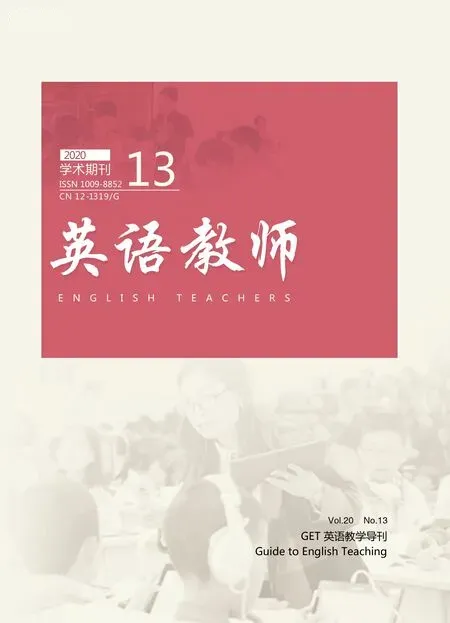高中英語閱讀教學(xué)中發(fā)展學(xué)生思維品質(zhì)的探索與實(shí)踐
陳麗仙
一、問題的提出
學(xué)生思維品質(zhì)的漸進(jìn)提升是英語學(xué)科核心素養(yǎng)中心智特征的體現(xiàn)(梅德明、王薔 2018);發(fā)展思維品質(zhì)能讓學(xué)生分析問題和解決問題的能力得到發(fā)展,這也是英語課程的最終目標(biāo)之一。然而,從教學(xué)實(shí)踐中發(fā)現(xiàn),很多教師并沒有真正落實(shí)在英語課堂上給學(xué)生創(chuàng)造各種發(fā)展思維品質(zhì)活動的要求,要么流于形式,要么講解語法知識和詞匯,根本談不上發(fā)展學(xué)生的思維,何談培養(yǎng)學(xué)生的思維品質(zhì)。鑒于此,提出在高中英語閱讀教學(xué)中應(yīng)重視發(fā)展學(xué)生的思維品質(zhì)。
二、發(fā)展學(xué)生思維品質(zhì)的理論依據(jù)
《普通高中英語課程標(biāo)準(zhǔn)(2017年版)》明確提出,“英語學(xué)習(xí)的目的不僅僅是對語言知識和技能的習(xí)得,更重要的是培養(yǎng)學(xué)生的英語學(xué)科核心素養(yǎng),即語言能力、文化意識、思維品質(zhì)和學(xué)習(xí)能力”(教育部2018)。思維品質(zhì)是英語學(xué)科核心素養(yǎng)的四大重要組成部分之一。培養(yǎng)思維品質(zhì)就是培養(yǎng)學(xué)生的邏輯思維、批判思維、創(chuàng)新思維,讓他們通過分析、概括對各種觀點(diǎn)進(jìn)行正確評判,創(chuàng)造性地發(fā)表自己的看法,使其具備多元思維的意識和創(chuàng)新思維的能力(程曉堂 2017)。這就要求教師設(shè)計(jì)各種能幫助學(xué)生提升思維品質(zhì)的問題。
三、在高中英語閱讀教學(xué)中發(fā)展學(xué)生思維品質(zhì)的方式
(一)設(shè)計(jì)基于閱讀文本的有深度的活動,提高學(xué)生的邏輯性思維
在高中英語閱讀教學(xué)中,很多教師只是單純地讓學(xué)生做判斷對或錯(cuò)(True or False)的練習(xí),或者回答簡單的問題,或者跟著課件的思路走,沒有深入挖掘文本背后的隱含信息,無法促進(jìn)學(xué)生多維度思考,也很難培養(yǎng)其思維品質(zhì)。真正的培養(yǎng)學(xué)生思維品質(zhì)的閱讀課堂應(yīng)該挖掘文本背后的深層信息(inner information),設(shè)計(jì)有深度的問題,提高學(xué)生的邏輯思維能力。
1.研讀閱讀文本的標(biāo)題,提高學(xué)生概括主旨的能力
人教版高中英語教材中的每篇閱讀文本都有標(biāo)題。標(biāo)題往往是文章的中心。引導(dǎo)學(xué)生研究文章標(biāo)題,是英語整體教學(xué)法在閱讀課中的運(yùn)用。教師可以設(shè)計(jì)與標(biāo)題相關(guān)的問題,引導(dǎo)學(xué)生思考,從而促進(jìn)他們思維的發(fā)展。
例如,在講授人教版高中《英語》必修1 Unit 2 English Around the World時(shí),在讓學(xué)生快速閱讀完文本內(nèi)容后,教師可以引導(dǎo)他們仔細(xì)觀察標(biāo)題,并提出以下兩個(gè)問題:
Question 1:Can you tell me why this title is the most suitable?
S1:Because it summarizes the main idea of this passage(the development of modern English).
Question 2:Please list some other titles and by comparing them,please say out what features the best title have.
這樣的問題能培養(yǎng)學(xué)生深度理解文本的能力,同時(shí)能訓(xùn)練其邏輯性思維。
再如,在講授人教版高中《英語》必修4 Unit 2 Working the land時(shí),在學(xué)生略讀文本后,教師可以提出以下問題:
Question 1:Who is the pioneer and in what aspect?
Question 2:Why is he a pioneer? What achievement has he made?
Question 3:Why is he a pioneer for all people instead of for Chinese people?
Question 4:What qualities makes him be a great pioneer?
在回答這些問題前,學(xué)生需要弄清楚偉大先驅(qū)袁隆平的巨大貢獻(xiàn)——培育出雜交水稻,讓全世界人民有飯吃;袁隆平是農(nóng)業(yè)方面的先驅(qū)和開拓者,他具有無私奉獻(xiàn)的精神,把這一研發(fā)推廣到整個(gè)世界。以上問題有助于激發(fā)學(xué)生對偉大先驅(qū)袁隆平這一科學(xué)家進(jìn)行深層次探究,并饒有興趣地進(jìn)入文本閱讀,積極尋求答案。一方面,能提升學(xué)生的文本解讀能力;另一方面,能發(fā)展學(xué)生的邏輯性思維。
2.利用思維導(dǎo)圖建立閱讀文本框架結(jié)構(gòu),發(fā)展學(xué)生的思維能力
思維導(dǎo)圖是表征人們思維過程的一種圖示,是用圖的形式呈現(xiàn)人們的知識結(jié)構(gòu)和他們表征知識的思維,是使知識結(jié)構(gòu)和思維過程形象化、可視化的圖形工具(廖秀慧 2013)。思維導(dǎo)圖側(cè)重從篇章結(jié)構(gòu)的層面解讀文本,以形象的環(huán)形圖或其他清晰的圖形幫助學(xué)生構(gòu)建文本的框架,能把概念與概念之間、問題與問題之間、觀點(diǎn)與觀點(diǎn)之間建立關(guān)聯(lián)。對于一篇難度大且篇幅長的文章,學(xué)生很難在短時(shí)間內(nèi)理清其架構(gòu)并弄清楚段與段之間的邏輯關(guān)系,但利用思維導(dǎo)圖就能快速理清文章脈絡(luò)。例如:在講授人教版高中《英語》必修4 Unit 2 Working the land時(shí),教師呈現(xiàn)如下思維導(dǎo)圖:

學(xué)生看了思維導(dǎo)圖后,對文本的脈絡(luò)及段與段之間的聯(lián)系有了清晰的認(rèn)識,為進(jìn)一步理解文本內(nèi)容奠定了基礎(chǔ),為深層次理解文本所隱藏的信息提供了條件,且有助于培養(yǎng)邏輯分析能力。
3.與學(xué)生的生活建立聯(lián)系,提高學(xué)生的批判性思維
英語課堂教學(xué)應(yīng)與學(xué)生的生活建立關(guān)聯(lián),促進(jìn)他們對學(xué)習(xí)或生活進(jìn)行深度思考,提高其高階思維。這就要求教師在課堂上應(yīng)多角度設(shè)計(jì)與學(xué)生生活有關(guān)的問題,引導(dǎo)他們進(jìn)行批判性思維。例如,在講授人教版高中《英語》必修1 Unit 4 Earthquake時(shí),教師布置如下任務(wù):
After reading the passage,it is believed that during the Tangshan Earthquake,if the earthquake had hit Tangshan in the daytime,there would not have so many deaths and injuries;if there had been more earthquake-resistant buildings,there would not have so much loss;if people had noticed the sign of the earthquake,people in Tangshan would have escaped from it.
Question 1:So what is your understanding of natural disasters,especially an earthquake?
Question 2:How can you escape from the earthquake successfully?
Question 3:Thus,when our school holds the earthquake drills,what ought you to do?Why?
Ss:We should be serious about it including listening to the talk attentively and take an active part in it because only by doing so if the earthquake hits our city,shall we escape from the earthquake safely and survive.
先讓學(xué)生說出地震發(fā)生時(shí)該如何應(yīng)對,如何逃脫以避免傷亡;然后由教師補(bǔ)充,啟發(fā)學(xué)生在學(xué)校開展地震演練時(shí)該怎么做,提高其批判性思維能力。
(二)設(shè)計(jì)跨越閱讀文本的活動,提升學(xué)生的創(chuàng)造性思維
1.設(shè)計(jì)“說”的活動,提升學(xué)生的創(chuàng)造性思維
提高學(xué)生的思維品質(zhì),特別是提升其創(chuàng)造性思維是培養(yǎng)其英語學(xué)科核心素養(yǎng)的重要目標(biāo)之一。核心素養(yǎng)指導(dǎo)下的課堂教學(xué)需要教師創(chuàng)設(shè)各種真實(shí)的語言環(huán)境,激發(fā)學(xué)生原有的認(rèn)知,讓他們將生活、學(xué)習(xí)與特定的主題聯(lián)系起來,激勵(lì)其學(xué)習(xí)和運(yùn)用語言,通過討論和小組合作提升其創(chuàng)造性和創(chuàng)新能力。
例如,在講授人教版高中《英語》必修3 Unit 2 Healthy eating時(shí),教師在處理完閱讀文本后設(shè)計(jì)如下“說”的活動:
T:As we all know,a balanced menu is of great significance to manage a restaurant.But can we say that a balanced menu is the only aspect we should consider when we operate a restaurant?So when you run a restaurant,what are the other factors that can be taken into account?Now have a discussion in groups.
經(jīng)過三分鐘的討論,教師讓幾個(gè)小組展示他們的觀點(diǎn)。
Group 1:Location.
While running a restaurant,we had better set it in a crowded place,such as near a shopping center.
Group 2:Atmosphere.
We must create a comfortable,peaceful and homelike atmosphere where the customers can enjoy their meals and feel relaxed.
Group 3:Service.
We believe a good service will be helpful to catch more customers to come to eat and gain more competition in the market.Thus,we had better serve the customers with smiles.Also we would use polite,considerate and warm-hearted to account our service.
Group 4:Prices.
Lower prices and better service will win back more customers because it is believed that in case of the same quality,the cheaper the prices are,the better it is.
通過討論并表達(dá)觀點(diǎn),學(xué)生鍛煉了發(fā)散性思維,同時(shí)發(fā)展了創(chuàng)新和創(chuàng)造性思維,英語表達(dá)能力也得到發(fā)展。
再如,在講授人教版高中《英語》選修6 Unit 1 Art時(shí),在處理好while-reading后,為了讓學(xué)生能運(yùn)用從閱讀文本中學(xué)到的 The Middle Ages,The Renaissance,The Impressionism 和 The Modern Art四個(gè)時(shí)期的繪畫作品的相關(guān)知識,教師設(shè)計(jì)如下“說”的活動:
T:After reading the passage,look at the following 2 pictures.Please use what we have learned in the reading passage to describe the paintings and analyze the painters.As is known to us all,Mona Lisa is Leonardo da Vinci’s masterpiece,which is still popular all over the world.Please analyze the feature of the painting,such as the background of the painter’s creating the picture and analyse the painting style of the painter too.
Question 1:Look at the second picture,which period does it belong to?
Question 2:What conditions resulted in the occurrence of the painting?
Question 3:What is the feature of the painting?And talk about the painter.
S1:It is a masterpiece of an impressionist whose painting style is different from the former ones due to a number of new inventions and social changes.They painted outdoors,trying to seize the light and shadow quickly.That’s why the paintings look unrealistic and absurd.
學(xué)生可利用從閱讀文本中學(xué)到的四個(gè)時(shí)期的繪畫作品的相關(guān)知識描述,剖析教師呈現(xiàn)的兩幅畫:一幅是達(dá)·芬奇的《蒙娜麗莎》,另一幅是印象派畫家莫奈的代表作《睡蓮》。這樣,既激發(fā)了他們的想象力,又給他們創(chuàng)造了使用語言的機(jī)會,培養(yǎng)了他們的創(chuàng)造性思維。
2.設(shè)計(jì)“寫”的活動,提升學(xué)生的知識遷移能力
閱讀文本的最佳境界是提煉觀點(diǎn),能用學(xué)到的知識和能力解決新問題。這就要求教師能創(chuàng)造性地設(shè)計(jì)超越文本的活動。超越文本的活動設(shè)計(jì)應(yīng)該是依據(jù)閱讀文本中的details,concepts等,并在此基礎(chǔ)上加以拓展和創(chuàng)新(inferring and creation)。設(shè)計(jì)這種超越文本的活動的目的是延續(xù)文本并加以拓展運(yùn)用,從而提高學(xué)生的高階思維。
例如,人教版高中《英語》選修6 Unit 3 A healthy life的閱讀文本是一封爺爺寫給孫子的信,用溫和的言語,結(jié)合自己的經(jīng)歷循循善誘地勸導(dǎo)孫子戒煙。在完成careful-reading后,教師設(shè)計(jì)如下超越文本的活動:讀后寫作。
假如你的好友李華已有多年的吸煙史,近幾天他感到身體不適,請你結(jié)合課文給他寫一封建議信,說服他戒煙。
內(nèi)容包括:
(1)抽煙的危害;
(2)給出戒煙的建議(至少兩條);
(3)表達(dá)期望。
這樣的設(shè)計(jì)能讓學(xué)生把從閱讀文本中學(xué)到的爺爺寫給孫子的建議信的語言知識及時(shí)加以應(yīng)用,有助于提升他們的知識遷移運(yùn)用能力。
又如,在講授人教版高中《英語》必修2 Unit 2 The Olympic Games時(shí),教師提出具有批判性的問題:“What do you think of the ancient slavery?”然后把學(xué)生分成三大組,要求他們根據(jù)文本續(xù)寫故事。故事的結(jié)局可以是喜劇(The two got married merrily)、悲劇(The poor young couldn’t run faster than Atlanta,he was thrown into prison.Unluckily he died soon),也可以是神話式的(The goddess of love saved the young man and he fell in love with the goddess of love)。
續(xù)寫故事留給學(xué)生足夠的發(fā)揮空間,可以使其大膽想象和預(yù)測。學(xué)生小組討論,各抒己見,最后形成文字。這樣的閱讀活動既能充分激發(fā)學(xué)生的想象力,提升其發(fā)散性和創(chuàng)造性思維能力,又能培養(yǎng)他們的知識遷移運(yùn)用能力,進(jìn)而提升其思維品質(zhì)。
結(jié)束語
綜上所述,發(fā)展學(xué)生英語思維品質(zhì)是高中英語教學(xué)的目標(biāo)之一,也是落實(shí)英語學(xué)科核心素養(yǎng)一個(gè)“窗口”。在高中英語閱讀教學(xué)中,教師在備課時(shí)應(yīng)深入了解學(xué)生的思維水平,結(jié)合閱讀課要達(dá)到的不同層次的思維目標(biāo),設(shè)計(jì)多種不同的能提升其思維品質(zhì)的活動,從低階思維到高階思維,不斷拓展其思維區(qū)間,從而實(shí)現(xiàn)課程目標(biāo)。

